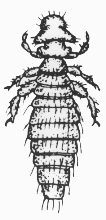4-H and Youth  |
| Home |
| How to Know Insects |
| How to Collect Insects |
| How to Preserve Insects |
| How to Display Insects |
| How to Identify Insects to Order |
| Field Identification |
| Where to Get Supplies |
| Reference Books |
| Insect Collection Checklist |
| Order Labels |
| Specimen Labels |
| Insect Card Points |
|
|
|
|
Mallophaga - chewing lice
|
 |
|

Chewing louse
Menoponidae
1/16 in.
The chewing lice gain their name because they feed on bits of hair, feathers, scales, and dried blood. They are wingless, flat-bodied insects, parasitic on birds and, to some extent, mammals (warm-blooded animals that have hair). They develop with incomplete metamorphosis.
Chewing lice attack all kinds of wild and domesticated birds and many common mammals. The eggs are glued to the feathers or hair of the host. Chewing lice are most often collected directly from the host. Standard precautions must be taken when handling animals to prevent transmission of diseases to humans.
|
|
|
|

